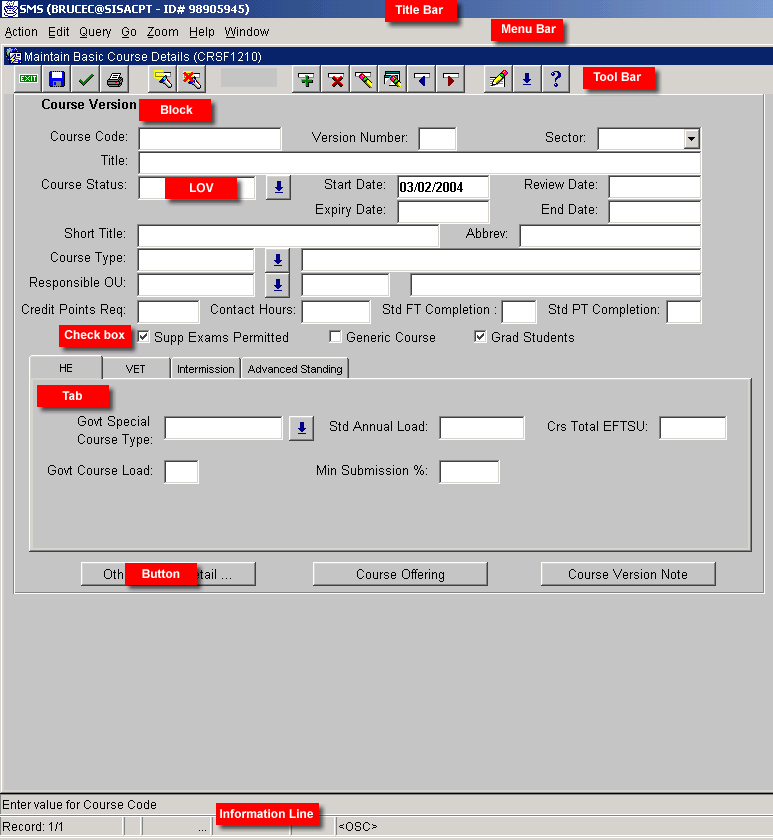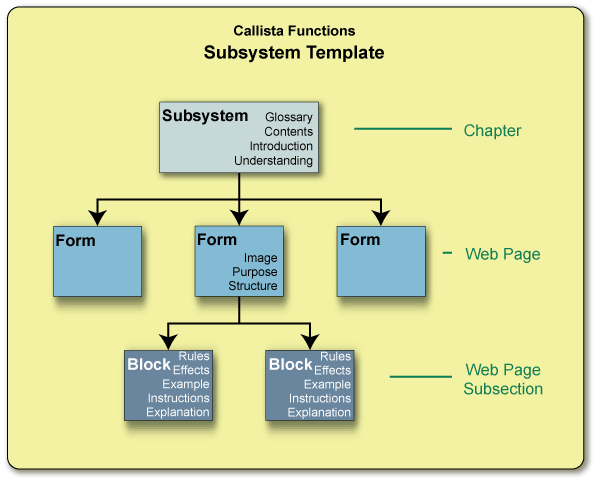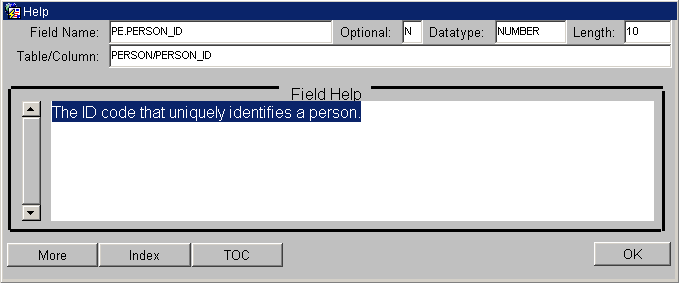
| Top of OVW | Index | Table of Contents | Feedback |  |
The System comes complete with comprehensive user documentation (User Manual) and on-line help facilities. On-line help is provided at the individual field level.
The User Manual is on-line. The manual has been designed to give you an understanding of the System, detailed instructions for processes and a ready source of reference. It is described in detail later in this chapter. These pages have been designed for printing from your web browser.
It is intended that the On-Line User Manual should be your first resort when you are requiring information.
To achieve this it is important that you are confident that the manual will provide the answers you require. Consequently, provision has been made for you to easily provide on-line feedback regarding this manual should you have any suggestions for improvements. This facility is detailed later.
Overview
The System contains an on-line version of the User Manual. This is almost identical to the hard copy version except for slight changes which make the on-line manual far easier to use.
The on-line manual utilises World Wide Web technology to present sections of the manual to users. It uses a web browser to view 'pages' of the manual. This allows the , bookmarking and printing functions of the web browser to be utilised. The primary advantages of using web technology are the ability to navigate rapidly between pages and the ability to incorporate graphics within pages.
The manual follows the structure of the System with each chapter being devoted to a particular Subsystem. A chapter is broken into a number of web pages with each web page documenting a single 'form' within the System.
fig. 1.3 - A Typical System Form (ovw09)

The picture above is of a typical System form. The parts of the form are labelled. In this case the form consists of two blocks. This can be related to the following diagram showing the template used in the layout of the User Manual.
Each web page relating to a part of SIS has been written to a standard template so that the structure of each web page is identical.
fig. 1.4 - Documentation Template (ovw02)

In the diagram above, a Subsystem is presented as a chapter of the manual, a form is presented as a web page and a block is presented as a subsection of a web page.
Pre-requisite
While it is not essential, it is advantageous for you to have some knowledge of the use of web browsers. Sufficient instruction will be provided here for you to be able to perform the necessary operations to access and use the on-line manual.
The on-line manual may be accessed directly from the Student Information System through the Field Help facility. There are three primary mechanisms for access:
Introduction
The Field Help facility provides context sensitive help on all fields within the System. In Field Help you will also find buttons which activate the on-line manual.
Accessing Field Help
There are three methods of activating Field Help:
![]() The
Help Icon
The
Help Icon
fig. 1.5 - Field Help Form (helpform)

The picture above is of a typical Field Help form. Contained within this form is the following information:
The above items are primarily of interest to System Administrators or staff generating ad-hoc reports.
Along the bottom of the Field Help form are buttons which are described below.
The On-Line User Manual is accessed via buttons in the Field Help form. There may be up to seven buttons which can be tailored to the needs of individual institutions. Most forms will contain at least the four standard buttons as shown in the previous picture. That is:
These four buttons are sufficient to fully use the on-line manual.
Hypertext links are a means of navigating between documents or to specific points within documents. The picture below shows a section of text containing hypertext links.
fig. 1.6 - Text Containing Hypertext Links (ovw03)

The text which is underlined and coloured blue, such as 'calendar category ', are hypertext links. In this case, clicking with the mouse on any part of the text will immediately display the definition for calendar category.
Tthe display of hypertext links (ie. colour, underline etc.) is dependent on how your browser is set up and may differ between browsers and from user to user.
In general, hyper(text) links will navigate the user to either:
At the top of most web 'pages' of the manual are four standard links. These are:
If in doubt, try the link. You can't break anything and it is very easy to get back to where you were by clicking on your browser's Back button.
Navigating Within the User Manual
Hypertext links allow rapid between parts of the manual. The web browser being used to view the manual also provides some tools. The picture below is of the toolbar in Netscape Communicator 4.03. Most browsers will have similar toolbars performing similar functions.
fig. 1.7a - Netscape Toolbar (ovw04)

Not all of the buttons provided are used for the on-line manual but they are still active and it is important to know what will happen if you click on them inadvertently.
fig. 1.7b
- Netscape Menu Bar (ovw43)

Most of the menu items are not directly relevant to the use of the manual. Two which are relevant are Go and Bookmarks. These are described later.
The Table of Contents lists the contents of the entire manual down to the level of individual web pages. The Table of Contents can be accessed via the button in the Field Help form or via the hypertext link at the top of nearly all pages of the manual. The picture below is of a section of the Table of Contents and shows how the different levels of information contained in the manual are indicated.
fig. 1.8 - Part of Table of Contents (ovw18)

Each of the entries shown underlined in the picture above is a hypertext link to the relevant part of the manual. For example, to see information about Government Course Types select the Table of Contents entry Course Structure and Planning from the left column and Maintain Government Course Types from the right column. Having visited the Table of Contents it is easy to return to it by either clicking on the Back button on the browser toolbar or clicking on the Table of Contents hypertext link at the top of the displayed page.
The manual contains a comprehensive keyword index to its contents. The Index can be accessed via the button in the Field Help form or via the hypertext link at the top of nearly all pages of the manual. Instructions for using the Index are also displayed on its first page.
The index is designed so that even if you are not sure of the exact name of the item you are looking for, you should still be able to locate it. For example, if you are seeking information about course offering patterns you would be able to commence searching the index using either course, offering or pattern as your primary search criteria.
The index entries are primarily nouns. For example, if you are searching for instruction on 'how to delete a course offering pattern' you should search on course, offering or pattern - not on delete. Verbs are used in the index only in relation to System wide processes. For example, 'deleting records' or 'moving between fields'.
A feature of the keyword index is the use of synonyms. If you do not know the correct terminology for the information you are seeking, a range of synonyms is provided to help initiate your search. For example, 'Date Alias Instance' may not spring readily to mind, however, the index contains entries for event and occurrence which will both lead to 'Date Alias Instance'.
Remember that there is a feedback facility within the on-line manual. If you can't find the term you are looking for in the Index, go to 'feedback' and record the fact and you will be advised what action will be taken to remedy the situation. Your opinion is valued.
The browser you are using, may have a function similar to Netscape's 'Go' menu option. The Go option permits direct to a page of the manual previously viewed in your current browser session. Each page has a title by which it may be recognised using this function.
To use the Go menu option to navigate directly to a previously viewed page of the manual (using Netscape):
Bookmarks may be a feature of the web browser you are using. They enable web pages which have been visited to be recorded in a list and recalled whenever they are required. This is particularly useful for pages of the User Manual which you visit frequently. The instructions below apply to the Netscape browser but most browsers will operate in a similar way.
To bookmark a 'page' of the manual to which you wish to refer regularly (using Netscape):
Tip: Some browsers allow you to create folders in which bookmarks can be organised. Try storing your bookmarks in a folder called SIS to separate them from other types of bookmarks.
To view a page that has been bookmarked previously (using Netscape):
To delete a bookmark you no longer require (using Netscape):
This facility may not be activated at your institution.
An on-line feedback facility has been provided as part of the on-line manual to allow you to quickly and easily report problems, make suggestions and record comments. Your opinion is valued and will help to improve the System. This facility provides the following option:
To use the feedback facility:
Printing Pages of the On-line User Manual
Your web browser should provide a facility to print web pages (see Navigating Within the User Manual, above). This will usually be a toolbar button labelled PRINT, or similar.
![]() Netscape
Print button.
Netscape
Print button.
Selecting the print option will cause the displayed web page to be printed. Remember that a web page can be more than what is displayed on a single screen. Most On-line Manual web pages are three printed A4 pages or less in length, however, the largest is around 24 pages.
Overview
Help is the term for all the resources which aid users in effectively using the System. Within the System there are three specific help mechanisms:
Warning messages are displayed to alert users to the results of a particular action. They are intended to allow a user to modify their course of action if they consider the result undesirable. They may also warn of the need to check results, check other data or perform additional operations. Warning messages are identified by the picture of an exclamation mark in a yellow circle. Below is a typical warning message.
fig. 1.9 - A typical warning message. (ovw06)

Warning messages should be read carefully to ensure that their message is understood and any appropriate action is taken.
The message is acknowledged and removed from the screen by selecting the OK button.
Some warning and error messages contain an additional button as shown in the error message in Figure 1.11. The Help button displays additional information regarding the error or warning message.
The error messages within the System are intended to assist the user in understanding their interaction with the System. They generally occur when an activity for which the System cannot cater is attempted. This may include both 'illegal' activities (involving incorrect data or actions) or 'out of bounds' activities where an activity requires the System to perform functions for which it was not designed.
Errors are notified by a pop-up alert which signifies that an error has occurred. They are identified by 'Error' in the form title bar and a large red stop sign.
fig. 1.10 - A typical error message. (ovw07)

Error messages should be read carefully to ensure that their message is understood and any appropriate action is taken.
The message is acknowledged and removed from the screen by selecting the OK button.
Some warning and error messages contain an additional button as shown in the error message in Figure 1.11. The Help button displays additional information regarding the error or warning message.
fig. 1.11 - A typical error message with help button. (ovw29)

Messages displaying a Help button will usually contain information written by users for the purpose of providing a clearer explanation of the error. Selecting the Help button will either:
Unhandled System Errors are advised to the user by a pop-up alert with the word Forms in its title bar. These are errors which have not been 'handled' by the programming of the System. This type of error should be notified to your Callista technical specialist who can consult the System Error Log to investigate the error further.
A hard copy version of the User Manual is not available. Individual web pages from the manual can be printed from your web browser. A hard copy manual is not intended for distribution to all users because of the limitations listed below. The primary source of user information should be the on-line manual. The main purpose of a hard copy manual is as a resource for people with responsibilities involving large parts of the System such as System Administrators. Particular uses might include user support, training development and ad-hoc report reference. In these cases relevant hard copy can be compiled from printed web pages.
Limitations
The primary limitation of a hard copy manual is the same as for all printed documents, that is, version control. There is inherent danger in issuing static copies of documents to staff as they are likely to be out of date very quickly. It is recommended that , apart from a few key personnel, users be encouraged to rely on the on-line manual as their information source. Printed copies of on-line manual 'pages' are readily produced where necessary.
The SIS User Manual is an enormous document containing over one thousand pages. The cost, waste of resources and inefficiency involved in distributing a hard copy version to users with a limited requirement for information make it unacceptable to do so.
A hard copy manual contains all the graphical features, especially colour, which the on-line version contains only while it is in electronic form. Colour printing would reproduce most of these features, however, it is unlikely that hard copy manuals for general distribution would be produced in colour.
The graphics in the hard copy version are linked to the document rather than saved in it. While this results in efficiencies in viewing and editing text, it makes transportation of the complete set of hard copy files difficult.
The SIS User Manual is only one part of the complete documentation necessary to efficiently operate the System. Complementary to the User Manual are written procedures and work instructions relating the business practises of an institution to its management of the System.
The development of written procedures is a matter for individual institutions and is not the subject of this manual. Provision has been made in the on-line help facility for the linking of on-line procedure documentation.
Last Modified on 10 December, 2004